
“Darden Smith: WESTERN SKIES – PRINTS AND DRAWINGS” is on view at Davis Gallery from September 23 – October 28. Photo: Davis Gallery.
Darden Smith is an interdisciplinary artist based in Austin, Texas. Drawing inspiration from his lifelong relationship with the Texas landscape, Smith’s upcoming solo show at Davis Gallery, WESTERN SKIES – PRINTS AND DRAWINGS, features over forty mixed media works works on paper and prints that integrate his practices as a visual artist, writer, and musician. WESTERN SKIES posits the Texas landscape as a dreamscape integral to Smith’s personal evolution, serving as a subject of meditation while he wades through emotional turmoil brought on by life’s changes.
In a conversation with Caroline Frost, Smith detailed the catalyst and development of WESTERN SKIES as a dynamic and multifaceted project that is molded by his keen perspective on how our attention to the surrounding environment reflects our internal realities. WESTERN SKIES — PRINTS AND DRAWINGS, Smith’s most recent iteration of the ongoing series, will be on view at Davis Gallery in Austin from September 23 through October 28, 2023. Davis Gallery will host an opening reception for the show on Saturday, September 23 from 4-7 p.m.
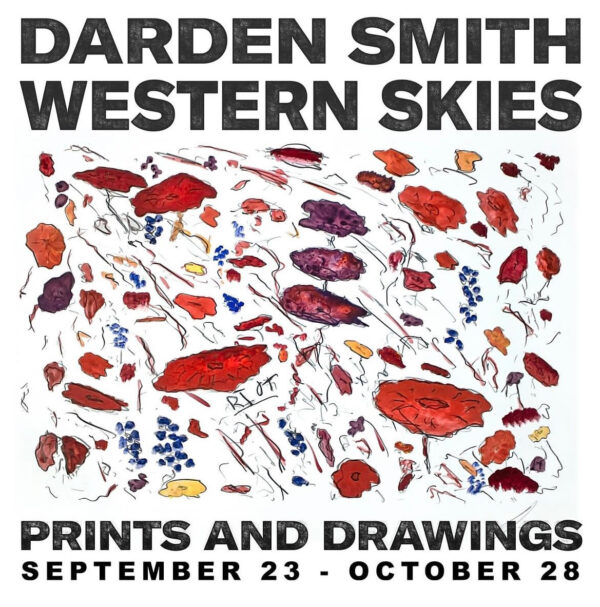
Darden Smith’s solo show, “WESTERN SKIES – PRINTS AND DRAWINGS” opens at Davis Gallery on Saturday, September 23. Photo: Davis Gallery.
Caroline Frost (CF): Your upcoming show at Davis Gallery, WESTERN SKIES – PRINTS AND DRAWINGS, draws inspiration from the Texas landscape. Are you from Texas?
Darden Smith (DS): Yes, I grew up in Brenham, Texas. I graduated from high school in 1980 and then went to Southwest Texas State (Texas State University) for a year and a half. I’m also a songwriter and musician, so while I was in school I was playing music in Austin. I wanted more of an urban city environment, so I moved to Austin to get that, and I’ve been here ever since. My work has taken me all around America and Europe, but I’ve always had the blessing of returning to Texas. The Texas landscape, and specifically the horizon, is very important to me and has been a foundational part of me since growing up in the country. It’s shaped how I look at the world.
CF: In your work, are you looking to the landscape as primarily a subject of contemplation and admiration, or is there an undertone of social or political commentary?
DS: I am political, but my work is not. I started drawing when I was really young, but I stopped when I was ten because people used to tease me about my drawings — I’m left-handed and I also had dysgraphia. I got tired of being teased about my drawings, so I quit and didn’t start drawing again until I was 30. Growing up in the country and spending a lot of time on my own is a massive part of my foundation, as is the mythology of the Texas landscape — not in a cowboys and Indians kind of way, but in the mythology that I created for myself. It doesn’t involve social or political issues that are relevant now, but it’s about the land as a dreamscape and what it evokes in me.

Darden Smith, “Miles Between,” graphite, gouache, watercolor, oil stick, gesso, and marker on Arches paper, 22 x 90 inches. On view at Davis Gallery, September 23 – October 28. Photo: Davis Gallery.
CF: How does WESTERN SKIES expand upon this personal mythology?
DS: WESTERN SKIES is a many-pronged project that started in 2021, during the pandemic. It began with a series of drives I took between Austin and Southern Arizona, where I had to go for a songwriting project. Before the second of these drives, I found this Polaroid camera in a box in my garage. I hadn’t seen this camera in over 25 years! So I got some Polaroid film, took it with me on these drives, and photographed along the way. It helped me to see the landscape in a different way, because Polaroids make you slow down since there’s no editing. It also doesn’t take a picture of what you think it’s going to take — it’s like it’s got a lazy eye.
These polaroids were capturing how I was feeling about myself, about the times that we were in, and about changes in my own life as I was getting older — my mother was very ill and she was dying, and my children were growing — but it was all held within these Polaroids. I began writing songs, not about the Polaroids necessarily, but as I’d look at the Polaroids, things would come to me. I wasn’t planning on making an album at all (I’ve made a lot of albums and I was kind of tired of it), but I had all these songs. So I went to this studio outside of El Paso, called Sonic Ranch, to do some demos, and on the second night I was standing there watching the sun go down, and I realized “Oh, this project is one thing.”
Since I’d also been writing essays and making drawings and paintings at the same time, I realized that instead of being three different projects, it’s one project — and it’s also a book! The book, titled WESTERN SKIES, is composed of all the Polaroids (which became lithographs in the show at Davis), the essays, and the song lyrics. So I made another album, put out a book, and created bigger drawings. The drawings aren’t based on the songs or the essays, but they’re all part of the same thing, and the landscape is key to that.
CF: It’s interesting to hear you describe the Polaroids as a reflection of your internal reality, because as I looked through the catalog of the show, it seemed like the mixed media pieces were more internalized or diaristic in a way that reflects your emotional state, whereas the lithographs (the Polaroids) seemed more external in that they document your surroundings.
DS: Totally, except I designed WESTERN SKIES with the concept that the project would be ongoing. From the essays, I also made a spoken word album, and I made a series of videos that go with that album, and I’m turning it into a one-man show. In the explorations around that one-man show, I realized that the Polaroids represented how I was feeling. Those feelings are represented in the land, and in some pictures that is an external thing, but the reason I took the pictures was because it forced me to slow down, and it actually changed the way I see and the way I look at things. So, the Polaroids capture an emotional state, but not in the same way the drawings do. The Polaroids reflect my intuition. I didn’t think about it much, it’s just what I gravitated to.
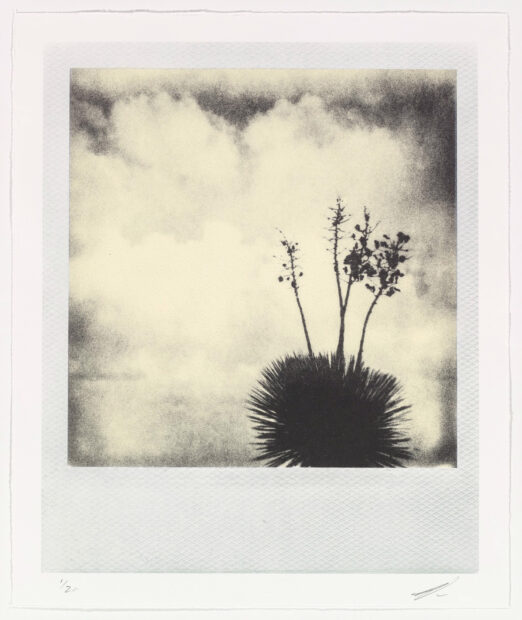
Darden Smith, “Yucca,” lithograph and silkscreen, 16.25 x 13.50 inches. On view at Davis Gallery, September 23 – October 28. Photo: Davis Gallery.
CF: How do the Polaroids and lithographs relate to the drawings featured in WESTERN SKIES?
DS: There’s a horizon line in almost all of the Polaroids, which wasn’t intentional. Additionally, there are vertical lines interrupting the horizon line: trees, stop signs, saddles, and mountains. In many of them, there is this vertical interruption, which is kind of like how I would draw. I don’t have a lot of art language, and I’m not trained in the arts, but if I were out there drawing, the Polaroid compositions reflect how I would draw the scene. So, everything is kind of a drawing.
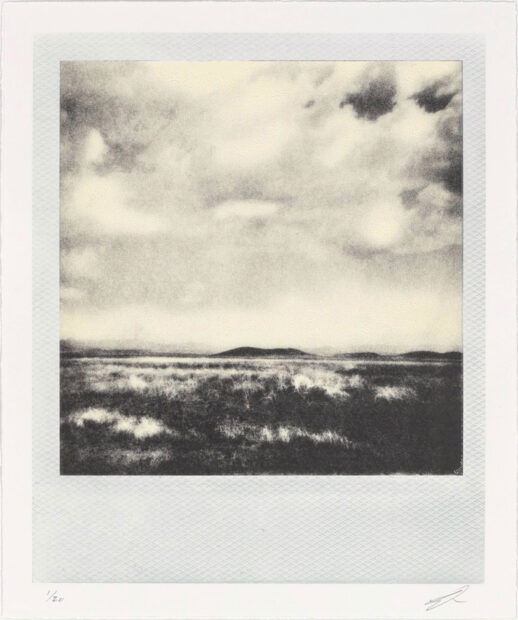
Darden Smith, “Black Hills,” lithograph and silkscreen, 16.25 x 13.50 inches. On view at Davis Gallery, September 23 – October 28. Photo: Davis Gallery.
CF: Does this body of work reference Texas landscapes exclusively?
DS: Almost all of it was done here in Texas. This summer I was at an artist residency at a friend’s place in Scotland called Airle Castle. While I was there, I did several of the big drawings, but I had the same Texas landscapes in mind as I was drawing them. I call them the field recordings, and they are all based on fields that I walked in when I was a kid, and landscapes that I saw in West Texas when I was walking around on those drives. So even though there are two geographical locations where I completed the drawings, they’re of the same place. It’s all connected.
CF: Your works, especially the drawings and mixed media pieces, feel like a stream of consciousness translated by hand. Does that resonate?
DS: Very much so. When I was in Scotland I was talking with Tarka Kings, who runs the residency with her partner (and is an amazing London-based artist), and she said that the thing about a residency is: there’s the work that you do and then there’s the thinking that you do. And oftentimes, the thinking you do is more important than the work that you do. So, while I was there I had this awareness that, because I’m not trained as an artist, the drawings convey a sense of dissonance.
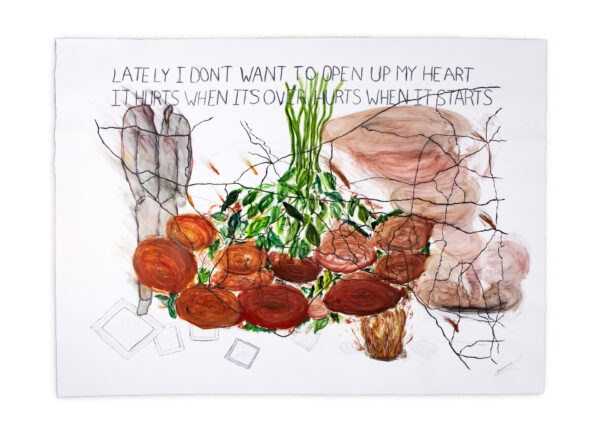
Darden Smith, “Lately I Don’t Want to Open Up my Heart,” gouache, graphite, watercolor, and marker on Arches paper, 44 x 60 inches. On view at Davis Gallery, September 23 – October 28. Photo: Davis Gallery.
CF: You use the phrase “rhythmic dissonance” to describe your work. Can you further explain what this refers to?
DS: In an urban situation, rhythmic dissonance would be like when you’re standing on the subway platform and everything is still, but the train is moving and is roaring while everything else is quiet. It’s like chaos within a form. Musically, I would translate it to things like Charlie Parker and jazz. If it’s too dissonant though, it’s just noise. There’s a chaos or dissonance that I’ve never quite been able to touch with my songs or music — and I’ve been doing this a long time. I’ve been writing songs for 50 years, since I was ten, and I’ve made 17 albums — but I’ve found it with the field recording drawings.
I was kind of getting there with the Polaroids, and then the lithographs were a little closer to it, but with the field recordings, it was like something opened up in me. There’s this dissonance within this form that’s still just a rectangle. It’s why I like coming into a drawing from the sides of the paper — there’s a form to it, and with this form, there’s a dissonance that I haven’t been able to find in music. I’m also really drawn to rhythmic dissonance in everyday life. I think it is funny when you see this beautiful setting and then there’s some litter. There’s some magical stuff happening, there’s a dissonance in life that I’m really attracted to as a writer and as a visual artist.
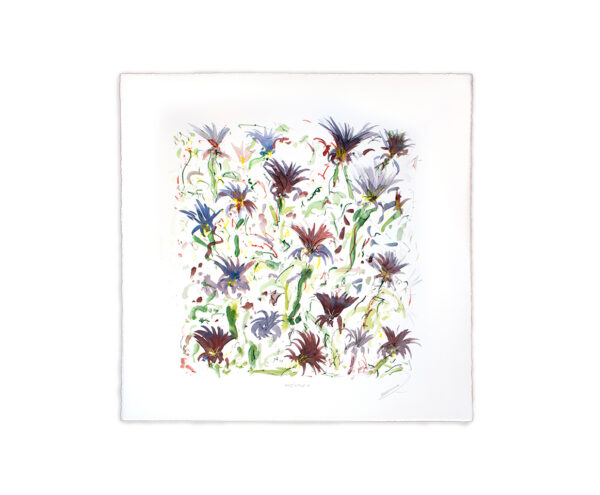
Darden Smith, “Thistle,” 2022, watercolor, ink on paper, 24 x 24 inches. On view at Davis Gallery, September 23 – October 28. Photo: Davis Gallery.
CF: Can you point to an example of rhythmic dissonance in the Texas landscape? And how do you translate that into your visual work featured in WESTERN SKIES?
DS: Roads. Underpasses. Going out I-10, you get to Kerrville and begin cutting through millions of years of sediment, and people just drive right by it; they don’t even see it. Also the roll of the wire between telephone poles. In Scotland, I realized that I’m attracted to dissonance in form, and form can be all kinds of things because it resonates back to when I was a kid on a farm in Brenham. I would wander around in the woods a lot, getting lost and finding my way home almost every day, allowing myself to get lost knowing I could find my way home. I’d talk to myself and to my imaginary friends and make up stories. It’s why I became a songwriter. This dreamy nature came about at this time. Especially as a kid, you get attached to that dreaminess.
So doing these drawings, the field recordings, I go right back into that dreamy state. It’s not childlike, but it’s a sensation that I’ve loved ever since I was very young. I remember walking in New York with a friend on 6th Avenue, right by Radio City at rush hour one afternoon, and it was very loud. My friend turned to me and goes “I love this shit man, it’s so quiet.” In situations like that, my brain just turns off, so it’s quiet in my mind. It’s like the sensory overload dissolves into white noise. Through drawing, I’m able to express that in a way I’ve never been able to before, and I feel so lucky to have found it at this point in my life. Now visual art feels like music did when I was a kid and I was just starting — it’s so freeing.
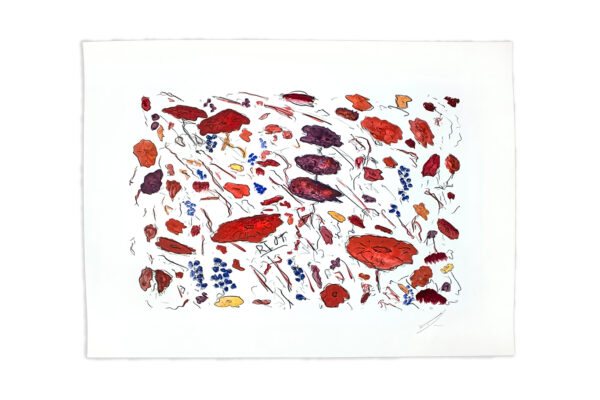
Darden Smith, “Blagdon Riot,” 2022, gouache, graphite and marker on paper, 24 x 36 inches. On view at Davis Gallery, September 23 – October 28. Photo: Davis Gallery.
CF: How does your music and songwriting manifest in your visual practice, and specifically, in the works included in WESTERN SKIES at Davis Gallery?
DS: It’s all the same thing. I’ve been doing music for so long that I still think in music metaphors. In terms of musical composition, every drawing has to have a chorus. It has to have something to hang onto; it’s got to have something that holds it together, or it’s just a bunch of scratches. It’s got to have a story. So, it manifests that way. In songwriting, working with words is so restrictive. It’s nice to not have any words, but by the same token, words keep creepin’ in. By bringing in song lyrics and titles, it all meshes together.
Being a songwriter, and having a life based around that up until this point, has given me a certain antenna that fine-tunes me to certain stories and humor. And it’s tuned my eyes in the same way it’s tuned my ears. I call the drawings “field recordings” because they are based on fields I was familiar with growing up or encountered on those drives in West Texas, and also because I put on records when I come into the studio and start drawing. I’m not drawing that record, but I make notations on the back of the drawings of what I was listening to when I made them. So, the music is in the drawings, but not in such a literal way.
CF: It’s operating too in some subconscious way.
DS: Absolutely. So music is part of the process, but also the craft of building a song has been formative in building a life, and now it’s present with me in how I approach my visual work. If you want to do it, you have to go to the studio. It’s not something that accidentally happens. You have to show up. To me, WESTERN SKIES is about showing up in a way that I hadn’t been able to show up before. Actually showing up to get to where I am now, and realizing that I can. And if I don’t show up, what a drag!
Darden Smith: WESTERN SKIES – PRINTS AND DRAWINGS is on view at Davis Gallery in Austin from September 23 – October 28, 2023. There will be an opening reception for the show on Saturday, September 23 from 4-7 p.m.
This interview has been lightly edited for length and clarity.




1 comment
Darden, your words are so
Incredible and your story is like your songs…
Inspiring all of us to hopefully share our story through a certain form of communication whether it be a drawing or as a song …it’s Beautiful! Thank you for it all!